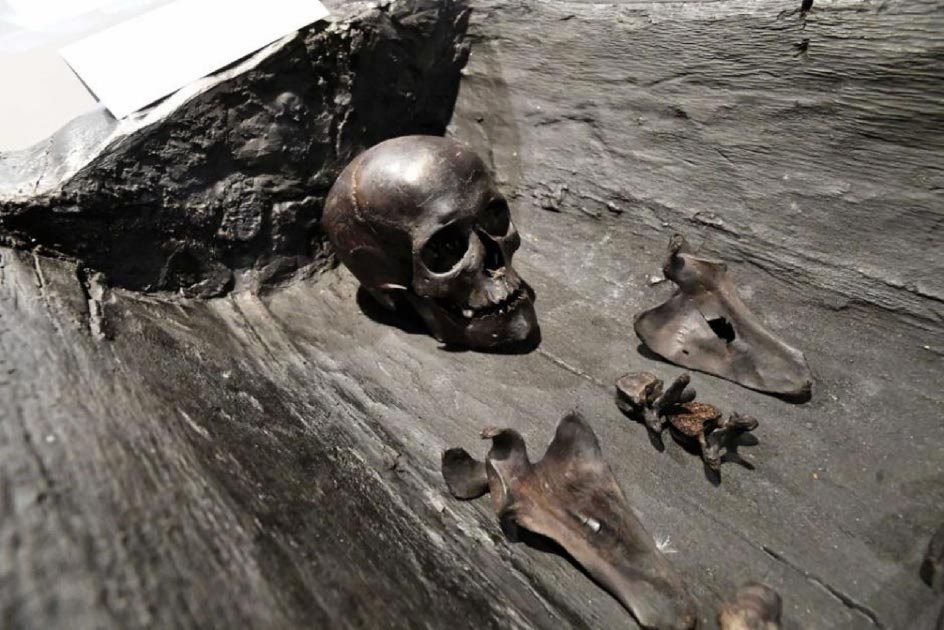Black Bones of a Polish Princess Modeled by Tech Geniuses
A 2000-year-old skeleton of a Polish ‘princess’ was thought to be impossible to scan because of its dark color. A group of tech wizards has been able to create a model of the skeleton despite the challenges and this will be used to recreate the face of the ancient woman. It can help researchers to understand her mysterious burial and life.
The skeleton was discovered at the end of the 19th century and found on a beach near the village of Bagicz, in the north of Poland. Curiously the skeleton was found in a hollowed-out log that had fallen from a cliff on the Baltic coast. When people looked inside the log to their amazement they ‘found the remains of the unnamed woman surrounded by jewelry, woolen clothing, and leather,’ according to The First News.com.

The remains were found on a beach in Bagicz. (archeologiabagicza.pl)
An Ancient Princess?
Carbon dating revealed the remains to be about 2,000 years old and that the woman lived around 100 AD. She died between the ages of 25 and 30 and suffered from arthritis. The woman was buried apart from a number of other graves which contained cremated human remains.
Academics believe that because of the nature of the burial the woman may have been from the elite and was possibly a princess. She was small in stature and in life stood only 145 cm tall or about 4 feet 9 inches. The skeleton had become discolored and its bones are black because it was in a log for centuries. It is nearly complete and there are 30 bones and the skull.
- Long Hidden Scythian Treasure Site Located at Ceremonial Spring in Poland
- Sigrid the Haughty, Queen Consort of Four Countries and Owner of a Strong Personality
- Mounds of Krakus and Wanda: Earthen Mausolea of Legendary Polish Aristocracy?
The skeleton had been kept in storage in the National Museum in Szczecin. It was decided to make a copy of the remains, so they were sent to the History Studio in Kołobrzeg for a three-year period. The intention was to ‘scan the original skeleton and then print out a copy using 3D technology,’ reports The First News.com.

The skeleton had become discolored and its bones are black because it was in a log for centuries. (archeologiabagicza.pl)
A Skeleton that was too Dark to be Scanned?
This is a procedure that has been successfully carried out many times. However, the History Studio was unable to scan the bones because they were so dark in color. The director of the History Studio, Robert Dziemba, is quoted by The First News as stating that “Everyone who has come here so far to make a copy has given up. No-one was able to scan it.”
However, a breakthrough was made when WOLF 3D, a company based in Warsaw, became involved in the project. They were able to scan the blackened bones and ‘managed the seemingly impossible,’ according to The First News. This company was able to scan the blackened bones and obtained data on the skull and bones. Then using a CAD computer package, they were able to produce a complete model of the skeleton. What is more, they did all this work for free.
- Ancient Slavic Woman Warrior Buried In Viking Graveyard With Her Brutal Weapon Of Warcraft
- Secret Chamber Found at Scythian Burial Mound Reveals Golden Treasure of Drug-Fueled Rituals
- Fighting in the Buff: Did Celtic Warriors Really Go to War Naked?
Bringing a Polish Princess Back to Life
The process of scanning the skeleton of the ‘princess’ took an entire day. The next step was to prepare for the 3D printing process which can take a few weeks. This will involve taking the scan of the ‘princess’ and turning it into an object by applying layer upon layer of materials.

The skeleton of the Polish ‘princess.’ (archeologiabagicza.pl)
The First News quotes Dziemba, “We will try to reconstruct her face. We will give her a little more identity.” Once the 3D printing of the scan has been completed, it will be sent to forensic experts. They will then use a variety of techniques to recreate what the woman looked like when she was alive.
The reconstruction of the face of the ancient woman could provide a better understanding of who the mysterious lady was. Now that WOLF 3D have successfully scanned the skeleton, it has been returned to the National Museum in Szczecin. They are also thinking about creating a visual presentation featuring the long-dead ‘princess.’
Top image: The blackened bones of the Polish ‘princess’ were discovered in a log on a cliff. Source: Marcin Bielecki/PAP
By Ed Whelan



















